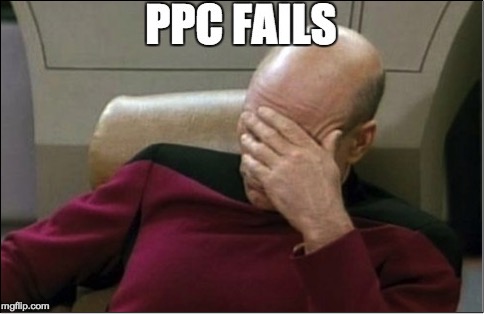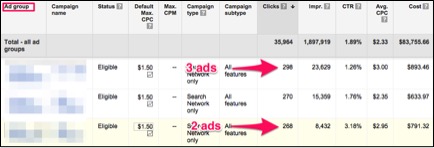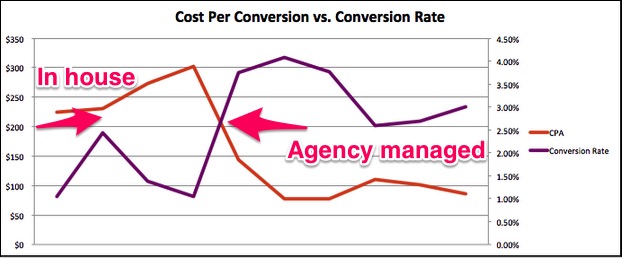In 2014, companies plan to spend $55.7 billion on search ads or 46% of total internet advertising dollars according to a recent tech crunch article. Given the massive amounts of money spent on search, I repeatedly encounter the same costly mistakes when I audit paid search campaigns. I’ve put together a list of the top 5 mistakes (FAILS) that I frequently encounter in paid search campaigns, along with possible solutions.
FAIL #1: Ad Copy
If your ad is in the top 3 positions, you want your ad to have an average CTR of 9% according to a presentation by Larry Kim, to have the best quality score (see slide 20). One of the mistakes we encounter are too many ads in rotation or only one ad per ad group. With too few or too many ads in rotation you’re not able to effectively measure the performance of your ads and find ads that increase click through rate. In most cases you want 2-3 ads per ad group. Here’s a good rule to determine how many ads to have in an ad group:
# of ads to run = # of clicks per month / 100
It’s critical to implement and utilize an ad copy testing process. I recommend starting a shared place to stage and then document the results of your ad tests. Document your learnings in order to avoid repeating losers but also to amplify your wins. You’ll want to be testing new ads as often as your volume allows but plan to test new ads monthly at the very least. To get started, use the scientific method we’re all familiar with from science class in high school.
What was your hypothesis? Were you trying to improve CTR? Conv. Rate? Both? Write your hypothesis down at the beginning of your test and then go back and document your learnings. When reviewing performance ensure you use statistical significance with your stats to be confident in your results. There are various tools online that you can use to measure statistical significance. Here’s my favorite ad testing tool. I’ve also really liked using this ad testing script in AdWords that will automatically alert you when your ad tests are complete.
FAIL #2: Campaign And Ad Group Architecture
How your campaigns are organized into campaigns and ad groups can be a major factor for campaign performance. Many people don’t put a lot of thought into structure or never revisit the hierarchy after campaigns are active.
Many times I log into AdWords or Bing and see the “Limited by Budget” alert in the dashboard, signaling a missed opportunity. You’re losing impressions on possibly valuable keywords because your campaign organization is weak.
Another problem I regularly see is advertisers that either don’t have a separate branded keyword campaign or they have their branded keywords grouped in with non-branded keywords. If you’re not bidding on branded keywords, you are blowing it. On average, advertisers see an overall lift of 40% in clicks to their website from this tactic alone. It’s also important to have these keywords in their own campaign because they perform much differently from other keywords and need to be managed differently.
FAIL #3: Ad Extensions
According to Wordstream only 30% of advertisers are using ad extensions. Using ad extensions in your ads will increase your click through rate around 10%. The dirty little secret about ad extensions is that nobody actually clicks them. The typical CTR on a sitelink is just 0.1%. Google now has 10 different ad extensions you can use in your ads:
- Sitelinks
- Location
- Call
- App
- Reviews
- Callouts
- Consumer ratings
- Previous visit annotations
- Seller rating
- Social
There’s got to be at least one of those that your company can use.
FAIL #4: Device Strategy
Mobile searches have increased by 200% year-over-year and are set to outpace desktop searches this year. Most of the accounts that we audit have no bid multiplier in place for mobile devices, or they have opted out of advertising on mobile devices. If this statement applies to you, you need to have a mobile strategy in place. AdWords and Bing have specific tactics available for mobile devices:
- Text ads
- Sitelinks
- Call extensions
You can customize all of these elements for mobile devices. Start by determining a place to set your mobile bid adjustments. Review how mobile devices perform on your website compared to desktop and set a starting mobile bid adjustment using this data. It’s also important to remember that real estate is limited on mobile devices and you need to target between ad positions 1-2. Test different bid adjustments and adjust based on performance.
FAIL #5: Scheduled Optimization vs. Ad Hoc
Most digital marketing managers log into AdWords irregularly. It’s critical to devote active time to maintenance, optimization, and expansion. I like to think of PPC accounts as a garden – How often are you pulling the weeds? Schedule time to login daily or at least weekly.
As an example – we had a client we partnered with for over a year and we were hitting all of our key performance indicators but they made a decision to take campaign management in-house. After they took the management of the campaigns in house they were not actively optimizing the campaigns. We saw these ensuing results.
- Conversion volume dropped 38%
- Cost per conversion increased 61%
- Conversion rate dropped 26%
Below is an actual graph of CPA vs. conversion rate over the time periods mentioned above:
We actually ended up assuming management of the PPC campaigns again and you can see that in the line chart above when performance started to improve again. Actively managing your campaigns is critical to success.
Conclusion
Managing PPC campaigns can be quite complex but please don’t FAIL on the fundamentals. What’s the worst PPC fail you’ve seen? Share in the comments below.







